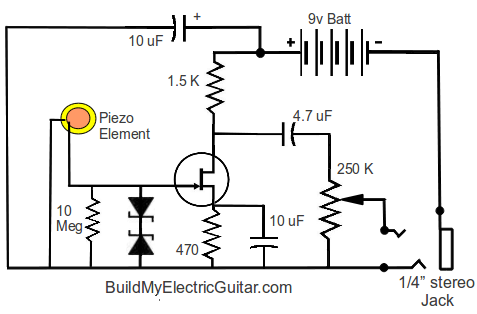Let me preface this by stating im a newbe at solid state design. I've built my own overdrive pedal that works great but to be honest I don't have a firm grasp on what every component does. I have a very simple and cheap piezo pickup that i am trying to amplify for use with guitar. I am using a 9v battery, a 4558 opamp, and a guitar jack output. I am going for the most simple/least components design. What I have right now works pretty good, I just need some help in fine-tuning. Here is the schematic I designed. piezopreamp.gif picture by Prattacaster - Photobucket
I actually have a 100uf cap on the positive voltage to smooth DC, it isnt shown on the schematic. Things I would like to see improved (in order of importance) are:
1) Resonates much more on certain notes, mostly being the Low E string and one octave above that, it does this regardless of placement and guitar used; electric or acoustic.
2) A little noisy overall
3) Mids are a bit nasally. Seems to be around 800-1k freq. I turn the mids down on my amp but the "mid-hump" is still there. I would say its upper mids, not quite to treble frequencies but close.
4) Slightly low gain, not to bad tho.
If i could fix these issues it would sound awesome, and i would be much appreciative.
I actually have a 100uf cap on the positive voltage to smooth DC, it isnt shown on the schematic. Things I would like to see improved (in order of importance) are:
1) Resonates much more on certain notes, mostly being the Low E string and one octave above that, it does this regardless of placement and guitar used; electric or acoustic.
2) A little noisy overall
3) Mids are a bit nasally. Seems to be around 800-1k freq. I turn the mids down on my amp but the "mid-hump" is still there. I would say its upper mids, not quite to treble frequencies but close.
4) Slightly low gain, not to bad tho.
If i could fix these issues it would sound awesome, and i would be much appreciative.

Comment